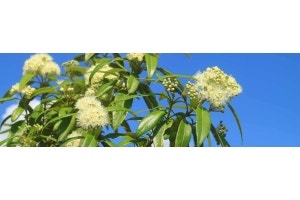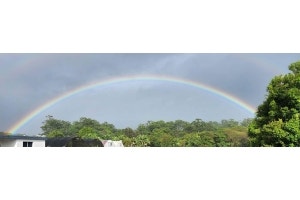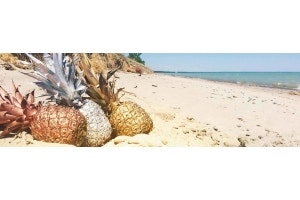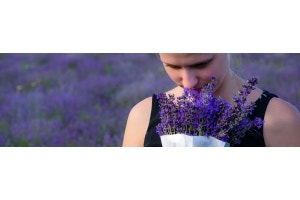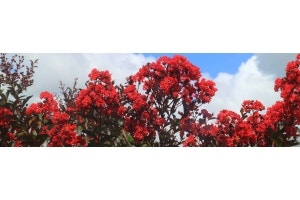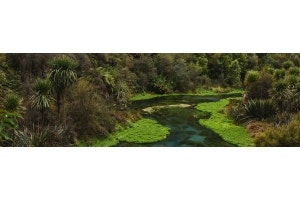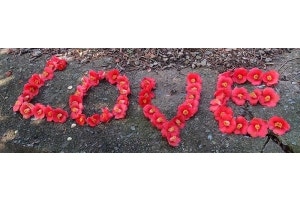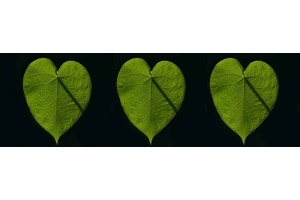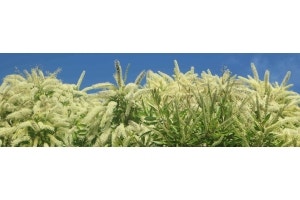
 We're not here to tell you how to vote.
We're not here to tell you how to vote.That's between you and the ever-growing ballot paper... Besides, if past data and advance registration is any guide, around 1.5 million of us vote well ahead of the polling date!
(pro = no queue; con = no #democracysausage)
Whichever way your political compass swings, we've got plants to show your true colours. More stylish than a pollie's face on a stick! Here, representing the main party colours in the House of Representatives and Senate, pre election, are :
Vote RED
 It's easy to keep the red flag flying in gardens.If you have a tropical or subtropical climate, choose anthurium for a shady border - the variety Success Red might be appropriate for you! If you're in a cold-winter zone, keep this one inside. NZ Christmas bush (Metrosideros)is a wow in full flower from dwarf hedges to tall trees; and if you have space for a shade tree, poinciana can't be beat for intense summer redness. For cold-climate regions there's spring tulips, and winter-flowering ornamental quince, welcome colour at that time of year.
Totally tropical hibiscus such as Cairo Red and Psyche (shown) are stunners in a sunny spot; there's a dwarf variety Medusa, perfectly sized for balconies and pots.
It's easy to keep the red flag flying in gardens.If you have a tropical or subtropical climate, choose anthurium for a shady border - the variety Success Red might be appropriate for you! If you're in a cold-winter zone, keep this one inside. NZ Christmas bush (Metrosideros)is a wow in full flower from dwarf hedges to tall trees; and if you have space for a shade tree, poinciana can't be beat for intense summer redness. For cold-climate regions there's spring tulips, and winter-flowering ornamental quince, welcome colour at that time of year.
Totally tropical hibiscus such as Cairo Red and Psyche (shown) are stunners in a sunny spot; there's a dwarf variety Medusa, perfectly sized for balconies and pots.
 In native gardens, plant giant gymea lily, and heaps of kangaroo paw - varieties Big Red, Bush Inferno, Bush Ballad, Bush Elegance, Bush Fury, and Frosty Red are the ones to choose. An essential native for the red garden is bottlebrush - almost any one you choose will be a vote-winner with the birds and bees in your neighbourhood. Captain Cook, Wildfire, and Scarlet Flame flower the heaviest in our nursery; and Little John is #1 with landscapers. You can't go past grevillea in a native garden; there's heaps of red varieties so we recommend Deua Flame, Scarlet Sprite, Red Wings, and New Blood which flower from a young size.
In native gardens, plant giant gymea lily, and heaps of kangaroo paw - varieties Big Red, Bush Inferno, Bush Ballad, Bush Elegance, Bush Fury, and Frosty Red are the ones to choose. An essential native for the red garden is bottlebrush - almost any one you choose will be a vote-winner with the birds and bees in your neighbourhood. Captain Cook, Wildfire, and Scarlet Flame flower the heaviest in our nursery; and Little John is #1 with landscapers. You can't go past grevillea in a native garden; there's heaps of red varieties so we recommend Deua Flame, Scarlet Sprite, Red Wings, and New Blood which flower from a young size.
Add to your garden the colourful leaves of nandina and photinia hedges, and azalea - Red Wings, Autumn Fire, and Autumn Bravo are the reddest.
 Plenty of native trees vote red : firewheel tree (Stenocarpus), tree waratah (Alloxylon), flame tree (Brachychiton), flowering gum (Corymbia, Eucalyptus), and NSW Christmas bush (Ceratopetalum). Ra ra team red!
>> See More Red Flowers Here
Plenty of native trees vote red : firewheel tree (Stenocarpus), tree waratah (Alloxylon), flame tree (Brachychiton), flowering gum (Corymbia, Eucalyptus), and NSW Christmas bush (Ceratopetalum). Ra ra team red!
>> See More Red Flowers Here
Vote BLUE
 There's not many true blue flowers in nature, but those there are, are very sought after. For a grassy natural look, plant liriope, native dianella, agapanthus, and spring flowering bulbs Dutch iris, and grape hyacinth.
There's not many true blue flowers in nature, but those there are, are very sought after. For a grassy natural look, plant liriope, native dianella, agapanthus, and spring flowering bulbs Dutch iris, and grape hyacinth. (Campaign season is also the time to plant spring flowering bulbs!)
 For bolder blue impact, there's evolvulus and convolvulus
For bolder blue impact, there's evolvulus and convolvulus plumbago, and the similar-flowered hydrangea. Plumbago is frost-tender and true to colour; hydrangea is frost hardy but only blue if your soil is acid. If your soil is neutral or alkaline, plant hydrangeas into containers of ericaceous compost to ensure you show the right shade!
Rarely seen and worth waiting for, are the pure blues of ceanothus or California lilac, blue butterfly bush (Clerodendrum ugandense), and blue-eyed grass (Sisyrinchum).
 Blue flowers, interestingly, are the most popular with bees and other beneficial pollinators. So when you plant a blue-flowered garden, you're casting a eco-vote for wildlife! Aromatic rosemary grown alongside herbaceous blue favourites salvia (especially African Sky, Marine Blue, and Costa Rica cultivars); ajuga or bugle, and catmint (Nepeta) will fill your garden with busy buzzing.
Blue flowers, interestingly, are the most popular with bees and other beneficial pollinators. So when you plant a blue-flowered garden, you're casting a eco-vote for wildlife! Aromatic rosemary grown alongside herbaceous blue favourites salvia (especially African Sky, Marine Blue, and Costa Rica cultivars); ajuga or bugle, and catmint (Nepeta) will fill your garden with busy buzzing. They'll all grow in patio pots or flowerbeds, and are very useful in kitchen gardens too.
If you're really dinky di, then kangaroo lobelia (Dampiera), Baby Blue viola and morning iris (Orthrosanthus) will paint your garden native. Blue for you! >> See More Blue Flowers Here
Vote GREEN
 Green is the colour of nature and gardens, so showing your support for this party is easy as! There's heaps of classic reliable evergreens for all climates, especially when it comes to planting hedges: lilly pilly, viburnum, box, native holly hedge fuchsia, and conifers provide a wide range of texture and leaf size.
Green is the colour of nature and gardens, so showing your support for this party is easy as! There's heaps of classic reliable evergreens for all climates, especially when it comes to planting hedges: lilly pilly, viburnum, box, native holly hedge fuchsia, and conifers provide a wide range of texture and leaf size.
If you don't mind a little white flower with your green leaf, your hedge choice expands even more : carissa Desert Star, mock orange, port wine magnolia (Michelia) will give you handsome green hedges.
 Go big or go home with your green plants - these leafy lovelies will add a lush jungly vibe! Cold-hardy heat-tolerant acanthus, an especial favourite in Melbourne; (in subtropical climates Philodendron Xanadu is a favourite alternative)
Go big or go home with your green plants - these leafy lovelies will add a lush jungly vibe! Cold-hardy heat-tolerant acanthus, an especial favourite in Melbourne; (in subtropical climates Philodendron Xanadu is a favourite alternative)fatsia, looking tropical but surprisingly cold-hardy
;
massively popular tractor seat, (Ligularia) seductively curvaceous;
; and native bird's nest ferns (Asplenium). All ferns are good green choices for a garden; bird's nests are bold and impressive when full-grown, with super-glossy long leaves.
 Plants - or pets? These petite plants can go wherever you go - on your bedside table, on the kitchen worktop, beside your workstation, in your car cupholder. Fly the green flag proudly!
Our nursery mascot plant and always a favourite, Cousin It; we add hats and sunnies to ours for a bit of fun! Grow a whole lawn of fragrant daisy-studded chamomile,
Plants - or pets? These petite plants can go wherever you go - on your bedside table, on the kitchen worktop, beside your workstation, in your car cupholder. Fly the green flag proudly!
Our nursery mascot plant and always a favourite, Cousin It; we add hats and sunnies to ours for a bit of fun! Grow a whole lawn of fragrant daisy-studded chamomile, alongside the shorter, groundhugging mosses, cushion bush and Irish moss For lounge rooms and shady moist places, baby's tears is a cute choice. It's very like the super-popular shade groundcover pratia but without the starry flowers.
Team Green! >> See More Green Plants Here >> See Green Flowers Here
Vote TEAL
 It might be easy to vote Teal depending on your constituency, but it's really hard to find plants to match this colour! We won't be beaten in the polls at Australian Plants Online, so we've dug deep to curate this selection, so you can show your support inside and outside the home.
Look out for plants with glauca in the botanic name - this means blue-green. One of our most popular is Festuca glauca known as blue fescue grass .
Conifers often have this tone to their foliage, like leyland cypress Naylor's Blue and juniper Blue Carpet Look out too for native groundcover Cassia Blue and Clarity Blue , Ozbreed dianellas with silver-blue-green leaves. Carex Blue Wave and Blue Cascade are resilient adaptable grasses that will grow in most Aussie gardens. The super-rare Ixia amethystina is close to teal-blue, and we occasionally have this in our spring bulb range from March onwards. It's always the first to sell out when we do!
It might be easy to vote Teal depending on your constituency, but it's really hard to find plants to match this colour! We won't be beaten in the polls at Australian Plants Online, so we've dug deep to curate this selection, so you can show your support inside and outside the home.
Look out for plants with glauca in the botanic name - this means blue-green. One of our most popular is Festuca glauca known as blue fescue grass .
Conifers often have this tone to their foliage, like leyland cypress Naylor's Blue and juniper Blue Carpet Look out too for native groundcover Cassia Blue and Clarity Blue , Ozbreed dianellas with silver-blue-green leaves. Carex Blue Wave and Blue Cascade are resilient adaptable grasses that will grow in most Aussie gardens. The super-rare Ixia amethystina is close to teal-blue, and we occasionally have this in our spring bulb range from March onwards. It's always the first to sell out when we do!
 Life's a little easier for teal-lovers when you choose indoor plants, shade plants, and succulents. There's often some unusual leaf colour in these categories!
Super-sized Blue Moon peace lily has big dark leaves with a blue sheen on the new growth;
Life's a little easier for teal-lovers when you choose indoor plants, shade plants, and succulents. There's often some unusual leaf colour in these categories!
Super-sized Blue Moon peace lily has big dark leaves with a blue sheen on the new growth; blue star fern (Phlebodium) grows up into a bold super-wiggly fern for indoor enjoyment and planting outside in shady borders. Groundcover succulent Senecio chalk sticks will spread around your waterwise rockery, keeping the soil cool for larger plants to flourish Succulent Graptoverias Opalina, (shown) and Topsy Debbie pair unusual teal shades with silver and lilac hues. Toot if you're Team Teal! >> See More Teal Foliage Here in the Silver & Grey section

Staying Neutral?
If you prefer to show your allegiance in the ballot box rather than the garden bed, then pink and purple is the way to go!There's a huge range of flowers in all kinds of pink and purple shades from soft shell to deep magenta, plus shrubs and groundcovers with pink-purple foliage to complement.You'll get a garden that's super-pretty pastel, or full of bright drama, depending on how intense your colour palette is; and no-one will know which way you vote.Win Win!






